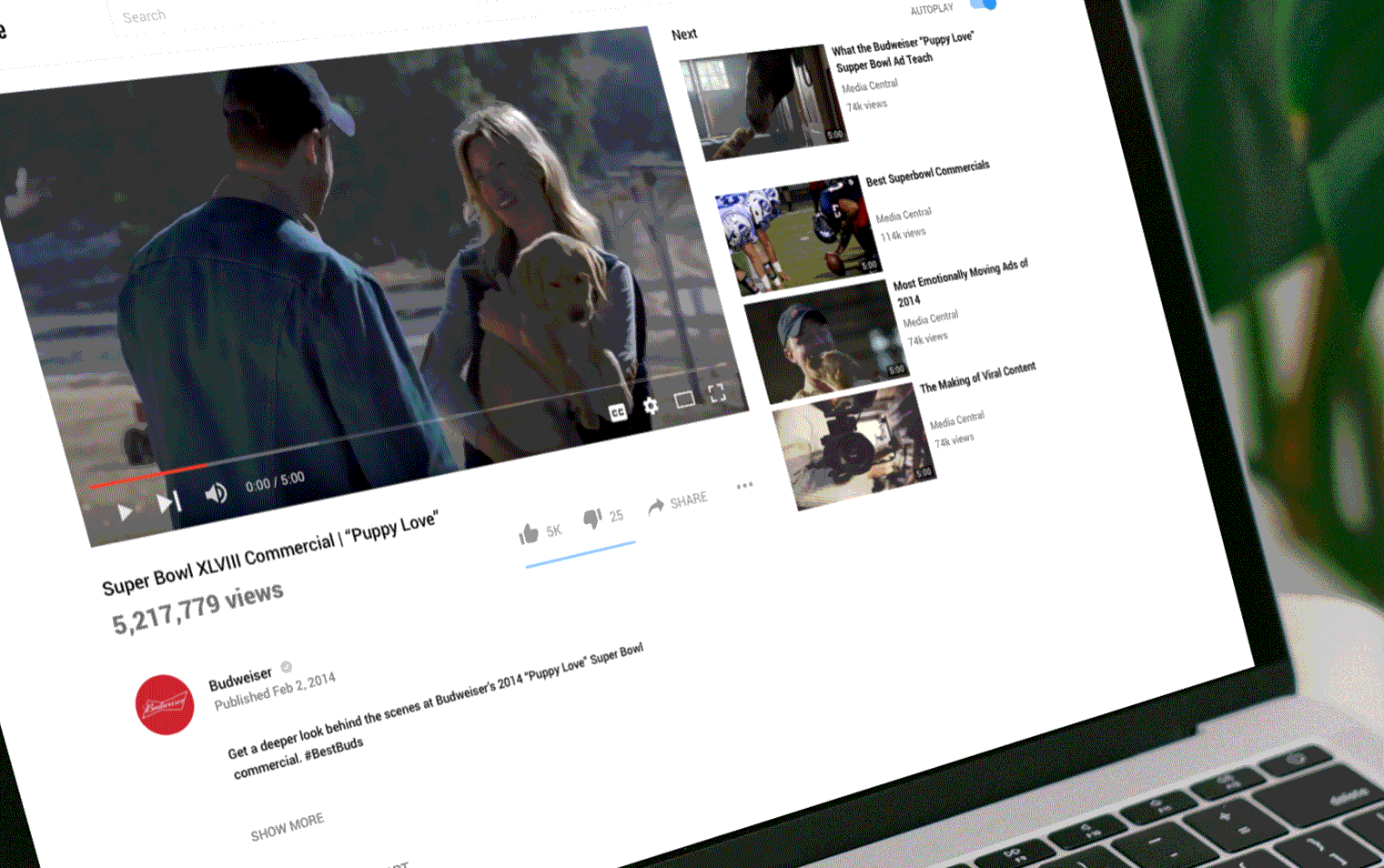
Thanks to the Fibonacci Sequence, a mathematical model that unlocks patterns that appear to be random, we’ve been able to observe patterns in everything from the shapes of nautilus shells and falcon flight patterns, as well as learn why galaxies zoom around the universe the way they do. And thanks to a team at the University of Southern California, we may finally be able to see the same in viral video content.
In Drivers of Virality (Sharing) of Online Digital Content: The Critical Role of Information, Emotion, and Brand Prominence — forthcoming from the Journal of Marketing — Gerard Tellis, Deborah MacInnis, Seshadri Tirunillai, and Yanwei Zhang, professors and actuaries at USC ’s Marshall School of Business, explore what drives people to amplify a given piece of content so much so that it “[counts] a large number of views in a short time period due to sharing,” their definition of virality.
The researchers began by testing and proving the validity of a set of hypotheses. First, they examined the real-world behavior of people who have actually shared ads across multiple types of media. Next, they coded sixty-plus ad characteristics that might influence sharing — far more than in previous studies. Then, they looked at the impact of discrete emotions on sharing, particularly the impact of storylines that unfold as dramas, a first for a study of this kind. Lastly, the authors replicated field findings across ads, raters (humans trained to score certain elements of a piece of content), runtime, and rating scales, and showed accurate out-of-sample predictability.
But what exactly did the researchers think was behind an ad’s virality?
Keep it to yourself, know-it-all
The first hypothesis the USC team considered was the belief that info-focused content negatively influences sharing, which their research bore out. Indeed, anyone who’s had to endure a minute-long unskippable YouTube bumper before getting to a five-second long, super hilarious clip from a twenty-year-old Simpsons episode has experienced this pain.
The study’s authors also found evidence of potential harm to personal reputation: “People risk reputational harm and lower prospects for self-enhancement when they share content that others do not find relevant, interesting, or compelling.” It’s unclear whether it’s you who sees the damage to your reputation or if you can tell by a change in others’ attitude towards you, but either way it’s a factor that advertisers likely haven’t considered. Can you guess beforehand whether your viewers will take a hit to their personal reputation by sharing your video content?
The shock of the new
Researchers at USC also wondered whether info-laden content for new products or services would have a positive effect on sharing. The answer? Oh, absolutely.
The USC team files this scenario under “product risk,” when something new might be attractive to consumers but is otherwise unknown, making them hesitant to give it a go. Those who do or who appear to strike out elevate “their reputation as . . . an opinion leader or a market maven. Burnishing one’s reputation in this manner is consistent with a motivation for self-enhancement” or, in non-academic terms, flexing for the ‘gram can actually do someone’s image good, not just make them look like — I don’t know — a twat.
So luxe, so money
The research team at USC did think, though, that information-focused content is more likely to be shared when it came to pricey products and services than for more affordable versions of the same goods and services. This hypothesis arose from the concept of “purchase risk,” which centers around high-priced items and boils down to the basic question, “Is this worth the money?” If a product or service is, in fact, not worth maxing out a credit card, the consumer will be out a lot of cash with little to nothing to show for it.
Researchers thus concluded that “consumers are generally attentive and receptive to information about the product or service” because they can weigh the information to minimize purchase risk.
Ta da! Creatives, you may have just found the reason for making product videos with high-production value.
“ . . . while reputation influences consumers’ decision to share or not share, altruism may also play a role.”
But more than that, while reputation influences consumers’ decision to share or not share, altruism may also play a role. “Consumers may share information with others to minimize the recipient’s purchase risk,” write the authors.
But is that really altruism or just self-interest disguised as such? The person who shares such information also puts themselves “in the position of one who is concerned about the welfare of the recipient, thus enhancing the self,” say researchers. But how you choose to interpret sharing may ultimately rest on your view of humanity. Do we, as Thomas Hobbes once observed, lead “nasty, short, and brutish” lives, or is every dawn bright and sunny?
Light versus dark
How you answer that question plays into the scholars’ next hypothesis: Content that arouses positive emotions such as love, pride, and delight is more likely to be shared compared to content that evokes negative emotions, like fear, sadness, and shame.
Again, don’t discount self-interest: “Receivers [of shared content] are likely to feel more positively inclined toward socializing with those individuals who make them feel good.”
No wonder ads like Budweiser’s “Puppy Love” from the 2014 Super Bowl are shared far and wide. Not only is that spot about the enduring friendship between a man and his dog, the dog is an impossibly adorable yellow lab puppy.
But dogs don’t always equal amusement and warmth. Think, for instance, of the Sarah McLachlan ASPCA ad. Every emotion that spot elicits is the exact opposite of what the USC team cites as necessary for viral success, and yet it seems safe to say that anyone who’s seen it just once — a full two minutes of ill, abused, helpless dogs and cats set to a song almost engineered to make you tear up — knows how heart-wrenching the whole thing is. It’s so sad not even Sarah McLachlan can watch it.
So while it may not be a viral phenomenon, that ASPCA spot may nevertheless have more enduring recall — the ad’s been airing for over a decade, after all — and that opens up the question of what constitutes success in advertising.
Tell me a story
With that question in mind, let’s turn to the authors’ next hypothesis: Content that uses drama and drama-supporting elements (e.g., a plot, characters, and surprise) positively impacts engagement and the arousal of emotions.
Develop a character properly, and audiences can better relate to that person whether they like them or not. Strike a balance between allowing enough time to let a plot unfold without going over the allotted run time, and audiences can more easily appreciate the plot’s richness. These are fundamental truths of decent filmmaking, and USC’s findings support their importance in viral success (with an emphasis on content that includes "babies, animals, and cartoons . . . because of their likeability or cuteness,” of course). But all too often in advertising, storytelling takes a backseat to product features, and the price is audience attention.
Enough about you already
The last hypothesis that the USC team tested was the suspicion that high levels of brand prominence (longer duration, earlier placement) in ads negatively impacts sharing.
But where does the line between advertising and branded entertainment lie? The USC team found it best if a brand was mentioned towards the end of a spot or if its logo came at the very end and only for the briefest of moments. “Although advertisers often want their brand name to be prominent to help recall at the time of purchase,” seeing branding liberally splashed all over your content about might cause a viewer to think twice about an advertiser’s motives.
And, according to the data, the more prominent the branding is, the less likely the content will be shared. In other words, the natural instinct of most clients may actually be detrimental to what they want to get out of so-called viral content.
The how-to at the end of the study
There’s no question that clients and even agencies can fixate on virality. If that’s what you’re after, USC has provided as close to a roadmap as is possible. Invest in high-quality production, cast lovable characters like babies and dogs, don’t harp on the brand behind it all, and viral success should follow. If someone demands content that'll go viral, establishing boundaries and guideposts like what USC has outlined will help keep the process on track, while ensuring brief creep remains at a minimum.
Yet the question remains: Does content made strictly for the sake of virality become entertainment, not advertising? Should we really be that hung up on going viral? Is going viral the best thing for a brand, or is it just the end result of a media plan, not some kind of organic phenomenon? And if we all follow the formula for virality, do we risk undoing the Von Restorff effect — the idea that what's distinct will stand out from an otherwise homogenous group — that virality itself is built upon? Like viruses themselves, maybe not all viral ads are good for us.






